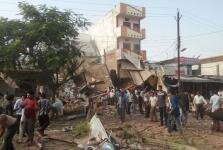The Ebola outbreak in West Africa was first reported in March 2014, and has rapidly become the deadliest occurrence of the disease since its discovery in 1976.
In fact, the current epidemic sweeping across the region has now killed more than all other known Ebola outbreaks combined.
Up to 27 December, 7,857 people had been reported as having died from the disease in six countries; Liberia, Guinea, Sierra Leone, Nigeria, the US and Mali.
The total number of reported cases is more than 20,000.
The World Health Organization (WHO) admits the figures are underestimates, given the difficulty collecting the data. WHO officials this week discovered scores of bodies in a remote diamond-mining area of Sierra Leone, raising fears that the scale of the Ebola outbreak may have been underreported.
The WHO has declared the outbreaks in Nigeria and Senegal officially over, as there have been no new cases reported since 5 September.
Researchers from the New England Journal of Medicine have traced the outbreak to a two-year-old toddler, who died in December 2013 in Meliandou, a small village in south-eastern Guinea.
In March, hospital staff alerted Guinea’s Ministry of Health and then MSF. They reported a mysterious disease in the south-eastern regions of Gueckedou, Macenta, Nzerekore, and Kissidougou.
It caused fever, diarrhoea and vomiting. It also had a high death rate. Of the first 86 cases, 59 people died.
The WHO later confirmed the disease as Ebola.
Disease spreads
The Gueckedou prefecture in Guinea, where the outbreak started, is a major regional trading centre and, by the end of March, Ebola had crossed the border into Liberia. It was confirmed in Sierra Leone in May.
In June, MSF described the Ebola outbreak as out of control.
Nigeria had its first case of the disease in July and, in the same month, two leading doctors died from Ebola in Liberia and Sierra Leone.
In August, the United Nations health agency declared an “international public health emergency”, saying that a co-ordinated response was essential to halt the spread of the virus.
Senegal reported its first case of Ebola on 29 August. A young man from Guinea had travelled to Senegal despite having been infected with the virus, officials said.
By September, WHO director general Margaret Chan said the number of patients was “moving far faster than the capacity to manage them”.
Director of the Centers for Disease Control and Prevention (CDC) in the US, Thomas Frieden, said in October that the Ebola outbreak in West Africa was unlike anything since the emergence of HIV/Aids.
Authorities in Mali confirmed the death of the country’s first Ebola patient, a two-year-old girl, on 25 October. The girl had travelled hundreds of kilometres by bus from Guinea through Mali showing symptoms of the disease, the WHO said.
Mali is currently battling a second wave of the deadly virus.
An infected Islamic preacher from Guinea, who was initially diagnosed with a kidney problem, was treated at a clinic in Bamako. The preacher died a few days after entering the country.
Two health workers who cared for the preacher also died after contracting the virus. In total, Mali has recorded six deaths from Ebola.
The first case of the deadly virus diagnosed on US soil was announced on 1 October. Thomas Eric Duncan, 42, who contracted the virus in Liberia before travelling to the US, died on 8 October.
He had not displayed symptoms of the disease until 24 September, five days after his arrival. Other people with whom he came into contact are being monitored for symptoms.
Two medical workers in Dallas, Texas, who treated Duncan tested positive for Ebola since his death but have both recovered.
Spanish nurse Teresa Romero was the first person to contract the virus outside West Africa. She was part of a team of about 30 staff at the Carlos II hospital in Madrid looking after two missionaries who returned from Liberia and Sierra Leone after becoming infected.
Germany, Norway, France, Italy, Switzerland and the UK have all treated patients who contracted the virus in West Africa.
Are cases levelling off?
Efforts to tackle Ebola have been hindered by fierce resistance from local communities with a history of suspicion towards outside intervention.
This has enabled new chains of transmission to pop up.
Over the last few weeks, health officials admit that the disease is now entering a new phase, with a marked slowing down in the some of the affected areas in the three countries, especially Guinea and Liberia.
According to the WHO, transmission remains intense in Sierra Leone, especially in the country’s west and north
2014 outbreak in context
Ebola was first identified in 1976 and occurs in regions of sub-Saharan Africa. There are normally fewer than 500 cases reported each year, and no cases were reported at all between 1979 and 1994.
In August 2014 the WHO confirmed a separate outbreak of Ebola in the Democratic Republic of Congo. By the beginning of October there had been 70 cases reported and 43 deaths.
However, the outbreak in DR Congo is a different strain of the virus and unrelated to the epidemic in West Africa, which now dwarfs all previous outbreaks.
Source





